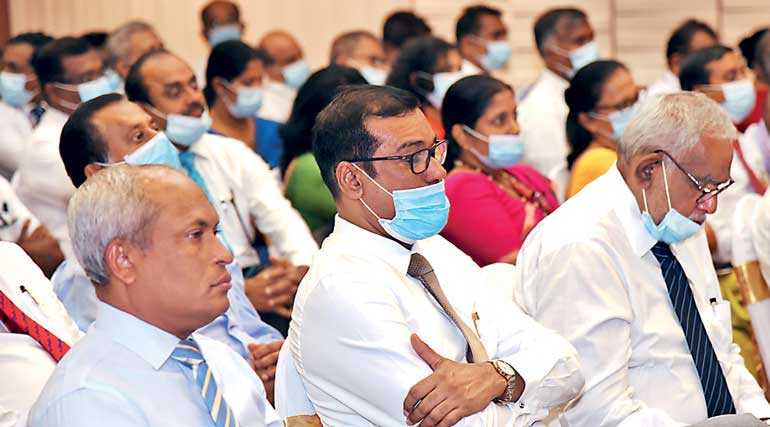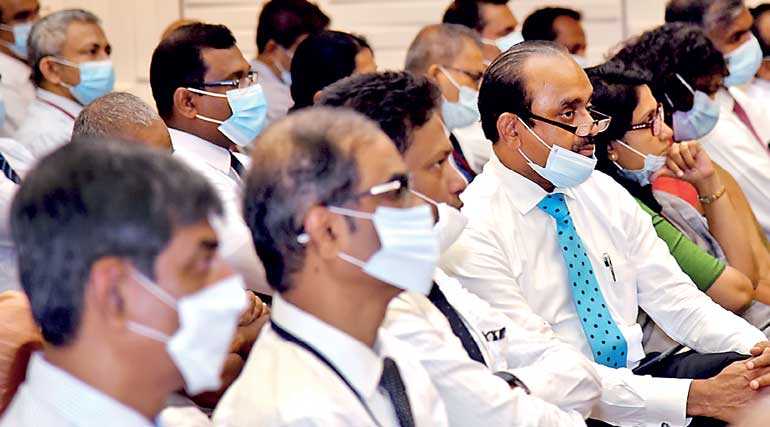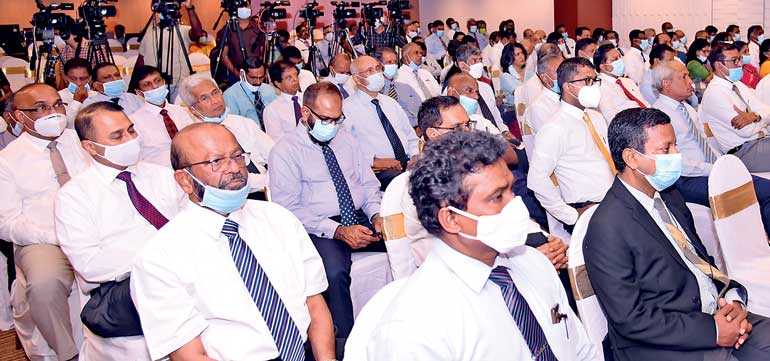Sunday Nov 16, 2025
Sunday Nov 16, 2025
Tuesday, 1 September 2020 00:18 - - {{hitsCtrl.values.hits}}

Central Bank Governor Prof. W. D. Lakshman - Pix by Ruwan Walpola
“Compromise is the essence of every economic decision. It must remain for those who are charged with the responsibility for determining the policies of the Central Bank constantly to weigh each of the above objects in the balance against the others and to decide from time-to-time the degree to which it can be achieved or must be sacrificed.”
The Central Bank was expected to establish monetary conditions in the country that would enable increased productive utilisation of the country’s human and material resources. In this regard, there was inherent recognition that freedom in monetary affairs reflected in the presence of a central bank would vastly influence the welfare and growth of the people through enabling effective mobilisation of national resources for production.
In this scheme of things, the Central Bank considered stable monetary conditions as the cornerstone to income and employment growth and also the lifeblood of foreign trade. As part of the economic institutional establishment of the State, it participated in activities proposed by elected Governments to promote long-term objectives of growth and employment generation, using the broad mandate it received from the MLA.

Compromise, prioritisation and reprioritisation, and balancing of objectives, as Exter himself indicated, are inherent in policymaking at a point of time, as well as in the evolution over time. Under different regimes and policy paradigms, we in Sri Lanka have achieved a great deal in terms of our desired national objectives of production and employment growth and overall socioeconomic development over the last 72 years of decolonisation.
Within its mandate, the Central Bank had participated in facilitating the implementation of these various policy packages, sometimes grudgingly but often accommodatingly. The people are, however, not content with socioeconomic results achieved so far through various policy packages.
Economic analysts, commentators and historians who have examined Sri Lankan achievements since Independence, in historical and international comparative perspective are equally unsatisfied about performance of these various policy packages.

Any careful reading of socio-political, economic and related developments in the country since 2019 would clearly indicate that we are yet again in a transitional phase in terms of many things, and economic policy matters occupy a dominant position in this transitional process. On innumerable occasions, we hear of the nation moving into an alternative economic and social policy framework. The Central Bank is naturally required to positively respond to these changes.
The COVID-19 experience which, I hope, we are moving out of, provided an emergency type phase for these required Central Bank changes in policy and practice. In order to address the unprecedented problems, issues and challenges thrown up by this pandemic, the Central Bank of Sri Lanka, following its peers in other countries, hand-in-hand with the other agencies of the Government, has provided the flow of required funds into the economy to meet the needs of the people under lockdown conditions.
COVID-19 experience has provided the country’s policymakers a valuable learning ground in their search for an alternative policy framework to lift the people on to a higher platform of social and economic achievements.
Direct or indirect financing of fiscal deficits has been viewed with caution in Sri Lanka. Nevertheless, there have been several occasions in the past when the Central Bank has stepped in to assist the Government in most difficult times.

The most prominent examples of these are the large expansions in Central Bank financing of the Government in the early 1980s during the beginning of the so-called open economy regime, at the height of the internal conflict in 2009, and very recently as already noted, during the COVID-19 pandemic.
When fiscal deficits need to be expanded to accommodate essential expenditure, it has now become an established practice for the Central Bank also to subscribe to such expansion, and act as a conduit in mitigating fiscal pressures to some extent. This function has become easier this year in the context of the prevailing low inflation environment.
As the German Development Institute in a briefing paper titled ‘Financing Global Development: The Role of Central Banks’5 highlights the changing approaches of central banks in the world: “In many developing and emerging economies, central banks have begun over the past decade to place renewed emphasis on the promotion of economic development and structural transformation, looking beyond narrow mandates for macroeconomic stability.”

The history of central banks
History of the role played by central banks in other countries, in the early stages of evolution of central banking, as well as in more recent times in the post-World War II period, shows that there were many instances in which these banks played an important role as agents and facilitators of development, although there were also unpleasant episodes such as the period of German hyperinflation.
In the more recent world history, the Central Bank’s “development agent role” came out very clearly in East Asian developmental states. These central banks have done this by using subsidised interest rates, legal restrictions, economic controls, directed credit and moral suasion to promote particular markets, institutions and sectors.
Central banks, playing their role as agents of development, have used credit controls to modify the pattern of credit availability, and to influence credit allocation patterns and interest rate structures.
Market forces do not necessarily channel credit flows towards sectors that have the potential to generate employment and add value in the domestic economy. The Central Bank has, therefore, occasionally acted to directly intervene in respect of credit allocation patterns.

At present, a mandatory lending requirement of 10% of total credit granted is in place in favour of agriculture credit. The inherent risks associated with this important economic sector and the consequent hesitancy on the part of banks to lend to agriculture were the factors responsible for this direct credit allocation intervention.
The credit schemes operated by the Central Bank itself, also take into consideration the reluctance of banks to lend to the small and medium scale enterprises (SMEs) and are often designed to absorb a large portion of credit risk. If the Central Bank were to take a more active responsibility as a developmental agent, these isolated types of exercises will need to be transformed as carefully crafted schemes of directed credit, operating within well designed economic plans.
Central banks in many countries have provided capital to development institutions, such as industrial and agricultural development banks. The development banks as opposed to commercial banks have been the source of funding for new investments. Central banks have often provided part of the equity of development banks. Sri Lanka has a poor history of development banking.
However, discussions are under way in the Central Bank to establish a national entrepreneurship development bank, which could support SMEs and startups. Also under discussion is a plan to introduce a permanent credit guarantee institution. These are avenues through which central banks in developmental states have actively supported domestic industries to grow and become global giants.
In addition to maintenance of the exchange rate at an appropriate level to support exports, capital controls and development finance systems have been used by these central banks to achieve developmental objectives. These methods were used effectively to bring down Government’s borrowing costs, to promote the development of particular economic sectors or industries, and to stimulate overall structural transformation of their economies.
In the developmental states, central banks became important mechanisms of industrial policy which helped as the main policy mechanism and the development model for economic transformation and diversification – the springboard for sustainable socioeconomic development. It is time, I believe, for Sri Lanka Inc. to develop its own business model.
From the time of introduction of open economy policies, together with relaxation of conditions governing determination of exchange rates, the exchange value of the rupee has continuously depreciated. The last decade, in particular, has seen depreciation pressures building up from time to time driven by various domestic and external reasons.
In the search for alternative economic policies since the change of Government in 2019, the Central Bank has intervened in foreign exchange market actively to bring about a relatively more stable exchange rate regime. Despite the limitations in official reserves, the Central Bank intervention has managed to stabilise the rupee exchange rate.
Greater success in this intervention requires successful action elsewhere in the economy – careful management of export-import trade activities, in important areas of export-oriented and import-replacing production and in sources of inflow of foreign exchange. If not for interventions in the foreign exchange and other markets, there would have been widespread panic in domestic markets, particularly during the COVID-19 related disruptions.
Of course, times have changed since 1940s and 1950s when there were frequent external current account surpluses to continued deficits, resulting in increased reliance on foreign borrowings to support the balance of payments, in the absence of adequate growth of exports and a regular inflow of foreign direct investment.
While timely intervention by the Government and the Central Bank has resulted in improvement of official reserve buffers to levels that are adequate to meet the country’s upcoming debt obligations comfortably, an irrefutable fact is that the country must aspire to enhance its foreign exchange earnings through sustainable means in order to help achieve the nation’s developmental objectives. We are confident that the ongoing focused efforts of the Government will help break this vicious cycle of current account deficits and overreliance on foreign debt.
As for inflation, monetary policy seeks to contain its demand-pull aspect. But, a large portion of the consumption basket in Sri Lanka, 28% in CCPI and 44% in NCPI, comprises food items. Given this large weightage on food in overall inflation, maintaining price stability requires close intervention by authorities to influence domestic production of food items. It is noted with satisfaction that the current long-term policy is one of restricting imports of food items which can be produced, domestically.
The looked-for alternative development policy framework would depend heavily on a productively and efficiently run sector of State-owned enterprises (SOE) and other public organisations. The dominance of large State-owned institutions in the financial sector often attracts criticism. But, in the Sri Lankan developmental State, these large State-owned financial institutions play a crucial role from several angles to assist and promote development.
These provide the support the Government needs. Without them, the financial sector would have become private sector-dominant with very little flexibility toward policy-dictated demands from the Government.
In addition, these large State-owned banks have operated for many decades in taking banking services to the people in areas remote from the metropolises, thus facilitating the outreach of banking services to unbanked segments of the population.
In the meantime, the existence of a few weak non-bank financial institutions has plagued Sri Lanka’s financial system, highlighting the need for consolidation, either voluntarily, or forcibly, if we are to maintain stability of the financial system. The Central Bank’s function of ensuring the financial system stability remains critically important not only for stable economic conditions, but also for growth of production and employment.
As the role of the State was of paramount importance, in early stages of a country’s development – to build up various elements of critical infrastructure and to undertake large investments in strategically important directly productive activity areas.
In addition, the Governments have large funding needs for various developmental purposes – eg. solidifying and extending their political authority, unifying the disparate components of the country under a central administration, promoting State-led and State-financed economic development projects as means of increasing State power, and, perhaps most important of all, purpose of protection of the nation against other competing states (Gerald Epstein, ‘Central Banks as Agents of Economic Development’, WIDER, 20066).
Large private economic entities which could take up these responsibilities were a later development. This pattern of development meant that, in the early phases of development of a country, the State required financing on a scale beyond the capabilities of individual private sector financial institutions. Many governments depended on central banks to fill the consequent institutional gap in respect of financing.
In the past several years, the Central Bank of Sri Lanka has implemented various measures to direct funding towards needy and productive sectors of the economy, such as the agriculture sector. It has implemented other measures to control the cost of credit and provide relief to disaster-struck industries such as tourism. It will enhance its efforts to direct lending to productive sectors in the future.
Given the practical issues in Sri Lanka’s financial system today, the responsibility of the Central Bank in respect of maintaining a healthy financial system acquires great developmental significance. The issues affecting the health of the financial sector, which includes non-bank financial institutions with varied financial strengths, require careful and firm handling.
The failure of one or a few such companies does not create a systemic impact, but such a failure causes significant impacts on society. Taking care of depositors of these companies is part of the social responsibility of the Central Bank.
Similarly, the intervention and guidance of the Central Bank are sought by stakeholders in various unregistered and unregulated small financial units among which there are micro-finance providers and small money changers. In terms of existing legal frameworks, the Central Bank has no responsibility in respect of lending agencies which do not take deposits from the public.
Yet, the country’s perennial issue of extensive indebtedness among people at low income levels is causing serious harm on the welfare of people. Their lack of bargaining power in the face of unfair practices of lending institutions, requires the intervention of the Central Bank to safeguard the rights of borrowers.
This would indeed be part of its responsibility in its developmental role. The presence of a large informal sector in the economy makes the developmental role of the Central Bank difficult and complicated.
With the establishment of the Central Bank of Ceylon, an institution of great economic significance emerged in the policy scape of the country. To date, its influence has not been limited only to areas of activity entrusted to it legally, but has extended to wider areas of significance. Over the past seven decades, Sri Lanka has crossed several milestones and made significant socioeconomic progress.
As rightly anticipated by Exter, the Central Bank of Sri Lanka has walked a tightrope in balancing economic stability with economic growth. While we can justly be proud of some achievements, we must acknowledge that the country is yet to attain its potential.
Despite the few spurts of growth observed, the overall growth trajectory has neither been significant nor sustained over time. Despite achievements, the important activity areas underlying growth, agricultural progress, industrial expansion and diversification, export growth and diversifications, savings and investment etc. have not advanced to achieve the country’s potential.
Against this backdrop, the growth of the economy, thus far, has not been of an inclusive nature. The alternative policy framework that is being developed has a lot to achieve. In the emerging developmental State, the Central Bank stands ready and willing to join hands with fiscal and policy planning authorities to help open up the vistas of prosperity for the benefit of the people.
Footnotes
5German Development Institute (2015), ‘Financing Global Development: The Role of Central Banks’, Briefing Paper 8/2015
6Epstein, Gerald (2006), ‘Central Banks as Agents of Economic Development’, United Nations University, World Institute for Development Economics Research